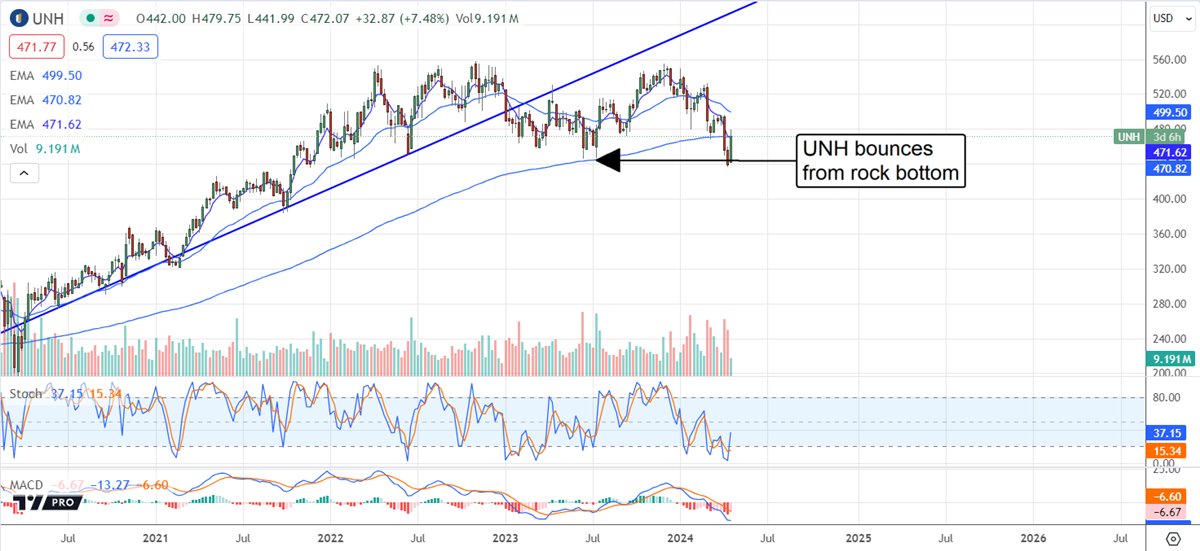
UnitedHealth Group's (NYSE: UNH) Q1 results were better than expected for two reasons: First, the stock price is now rebounding from long-term lows and deep value territory with ample upside ahead. Second, UnitedHealth analysts see it advancing more than 20% at the current consensus, and consensus may go higher because it's cautious.
The consensus estimate moderated ahead of the Q1 release because of fears that proved to be extreme. Now analysts will have to rework their estimates and likely revise price targets to be higher. Because results support the market and the stock has value and yield, bullish momentum could easily take this stock price to the high end of the analysts' range. That would put it back on the trend that began in 2020.
UnitedHealth Cyber Attack Impact Is Less Than Feared
UnitedHealth Group's results are good because of underlying business strength and a less-than-expected impact from the recent cyber attack. The company reported $99.79 billion in net revenue for a gain of 8.6% over last year, outpacing the consensus by 50bps. While 50bps is a slim margin, results could have been far worse given the scope of the attack. Optum grew quickest segmentally at 13% and was offset by slower growth in the core UnitedHealth segment. UnitedHealth's growth was primarily driven by an increase in the number of clients served.
The GAAP margin was deeply impacted by the sale of Brazil operations and the cyberattack. The impact of the Brazilian operations is primarily non-cash related to FX-translation losses; the cyber attack's impact is quantified at 74 cents per share, including 49 cents in direct response efforts and 25 cents in business disruption.
After adjusting for the effects of Brazil and direct response, but not business disruption, the net operating margin is flat compared to last year, and the EPS is above consensus. The $6.91 outpaced the consensus reported by Marketbeat by 29 cents and is compounded by improved guidance. UnitedHealth issued favorable guidance. The company expects adjusted earnings from $27.50 to $28 compared to the analysts' consensus of $27.53.
UnitedHealth's Cash Flow and Capital Returns Are Healthy
The cyber attack negatively impacted cash flow in Q1 and will this year, but the effects are limited, less than expected, and will diminish as soon as the current quarter closes. Regardless, the company's cash flow in Q1 was sufficient to weather the storm. Balance sheet highlights include a cash build offset by an increase in debt and liability and a single-digit decline in equity. The net result is leverage near 2x cash and 0.7x equity, both fortress-quality, allowing for dividends and share repurchases.
The dividend is above the broad market average, yielding about 1.7%. The payout ratio is low at 30% and compounded by share repurchases. The repurchases in Q1 brought the average adjusted share count down 1.4% and are expected to continue this year. A distribution increase is also likely. UNH has increased for 14 consecutive years and is on track to make the next increase when it declares a payment.
UnitedHealth Group Confirms a Bottom
The price action in UnitedHealth Group advanced more than 5% following the release to confirm a bottom at $450. The market is in rebound mode and likely to move higher. There is some resistance at the $480 level and short-term 30-day EMA, but it may not last long. A break above that level could take the market up to $500 or $520, where resistance may be substantial.
The long-term outlook is good. UnitedHealth should resume its long-term uptrend from that point due to insurance industry trends, margins and capital returns. The question is if it will trend moderately higher from this level or surge to the top of the analysts' range and realign with a previous trend.

